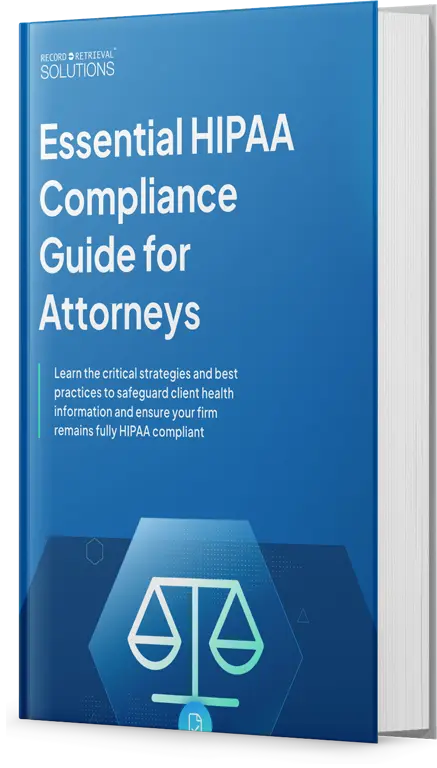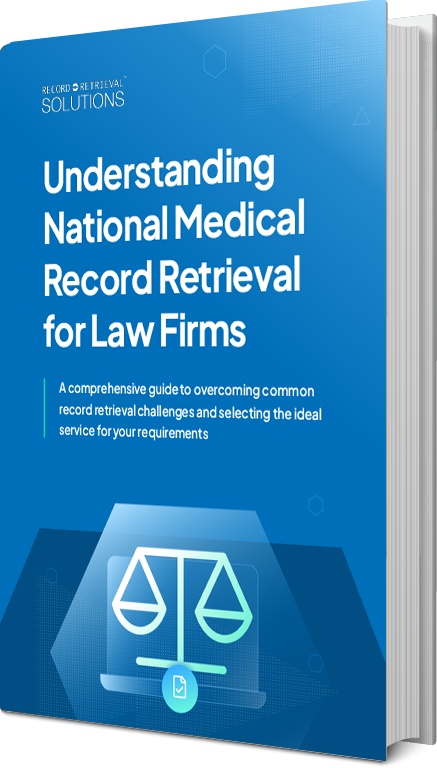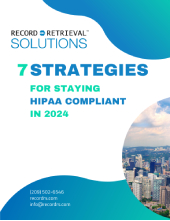Key Takeaways
- Your case proceeds more efficiently when medical record retrieval is complete, searchable, and packaged for court. RRS handles that end-to-end.
- We solve the common pain points: slow facilities, partial releases, image-only PDFs, duplicates, missing certifications, and last-minute gaps.
- Expect real speed (typical average around 15 days, facility-dependent), real visibility (live status and deficiency logs), and absolute compliance (HIPAA-aligned safeguards).
- RRS delivers trial-ready packets—indexed, OCR-searchable, Bates-labeled, and certification-backed—so your team spends time on argument, not document rescue.
- The ROI is tangible: fewer continuances and re-requests, reclaimed paralegal and attorney hours, and a stronger settlement posture with clean medical records for trial.
Why is RRS here for you?
You need the correct medical record at the right second. The obstacles are predictable: vague facility rules, unresponsive custodians, partial releases, and PDFs that cannot be searched on the fly.
RRS is designed to remove those friction points without forcing your firm to rebuild workflows. We manage the chase, quality, and courtroom packaging, so you can stay focused on strategy while we make the evidence easy to present.
What problems do we eliminate immediately?
- Slow or stalled providers. Weeks of drift and blown preparation windows are common when custodians don’t respond. RRS utilizes provider-specific request language, schedules systematic follow-ups, and escalates issues according to documented timelines until the release is complete.
- Partial or inconsistent releases. Gaps in liability, causation, or damages proof appear when facilities send incomplete packets. RRS verifies scope up front, tracks missing pages in a live deficiency log, and re-pulls items before they turn into a trial-week crisis.
- Image-only or low-quality scans. When PDFs aren’t searchable, your team wastes time scrolling. RRS runs optical character recognition (OCR) on every page, restores page order and rotation, and validates readability for court use.
- Duplicates and out-of-order pages. Disorganized packets create confusion during witness preparation and cross-examination. RRS de-duplicates files, re-sequences chronologies, and maintains stable Bates ranges across all versions.
- Missing certifications and provenance. Admission objections and delays arise when authentication is thin. RRS secures custodian certifications and provides a clear provenance summary that shows what was requested, when it was asked, and from whom it was obtained.
What exactly do you get from RRS?
A courtroom-ready packet, standardized across matters:
- Unified clinical record: History and physical (H&Ps), progress notes, operative reports, discharge summaries; imaging reads; labs; pathology; meds and allergies from Electronic Medical Record (EMR)/Electronic Health Record (EHR) sources.
- Billing and damages support: Itemized statements, explanation of benefits (EOBs) when relevant, charge details, and insurer correspondence aligned to damages narratives.
- Authentication: Custodian certifications/affidavits and a front-matter index with a clear table of contents.
- Searchability and navigation: Full-packet OCR, bookmarks for major sections, and a master index that points to page ranges your team actually uses in court.
- Provenance: A concise, auditable log of requests and releases, plus dates and scope confirmations.
Quality control that stands up in court
We don’t hand you a download link and hope for the best. Every packet runs through a documented quality process:
- Completeness check against the agreed scope (clinical, imaging, billing, certification).
- Readability check (blurry, skewed, rotated, or cropped pages fixed).
- De-duplication and sequencing to eliminate clutter and maintain a tight chronology.
- Searchability pass with OCR and validation that critical keywords surface as expected.
- Bates stability ensures that references made in meet-and-confer remain accurate in court.
The outcome: fewer surprises, faster prep, and confidence in-court retrieval.
Speed, visibility, and compliance—without the friction
- Speed you can plan around: The typical average turnaround is approximately 15 days (facility-dependent), with rush strategies employed when hearings or expert deadlines require expedited processing.
- Live visibility: You’ll see what landed, what’s missing, the last touch, and next step—no more digging through email threads to learn status.
- Compliance by default: We protect Protected Health Information (PHI) end-to-end with HIPAA-aligned safeguards, encrypted transfer and storage, role-based access, and access logs.
Implementation with zero disruption
We integrate with your existing intake and case-management processes. You hand RRS the matter details; we plan the requests, monitor releases, and deliver the finished packet.
No new software rollouts. No retraining. Start with one live case, validate the gains, and then standardize across the practice.
In short: You keep arguing the case. We make the evidence simple to use.
Conclusion
Trials reward teams that control the facts and the files. RRS makes that control practical: we own the medical record retrieval, provider wrangling, completeness checks, OCR and indexing, and courtroom packaging.
You receive clean, searchable, certification-backed packets that make evidence retrieval instant and reliable. That’s how your firm turns messy records into momentum—without burning staff time.
Ready to see the difference in a current matter? Send the case list and timeline; we’ll start delivering.
Do we need originals, or will certified copies work?
Certified custodian copies are typically sufficient and much faster. We secure certifications and include them in your packet with a provenance summary.
What if a provider delays or rejects requests?
We tailor requests to facility policies, maintain a documented follow-up schedule, and escalate when timelines slip, thereby reducing rejections and idle time.
What turnaround time should we expect?
About 15 days on average (facility-dependent); timing varies by scope, custodian backlog, and authorization quality.






